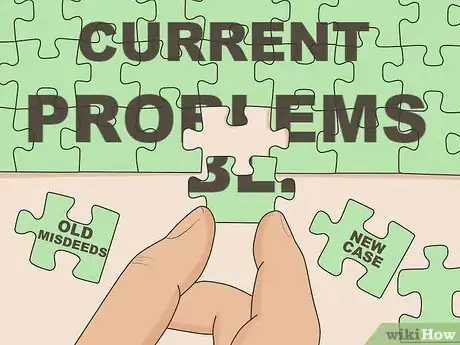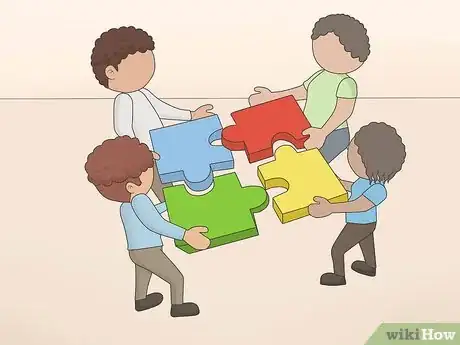This article was co-authored by Tasha Rube, LMSW. Tasha Rube is a Licensed Social Worker based in Kansas City, Kansas. Tasha is affiliated with the Dwight D. Eisenhower VA Medical Center in Leavenworth, Kansas. She received her Masters of Social Work (MSW) from the University of Missouri in 2014.
This article has been viewed 337,326 times.
Death, addiction, money troubles, mental illness, separation/divorce, and transitional adjustments all take a toll on the members of a family. During stressful events or when the family’s resources are severely taxed, problems may not be resolved easily. This may lead to hostile disagreements, tension, and resentment. Conflict in the family can affect everyone’s functioning. Handle your family problems by learning effective problem-solving skills.
Steps
Developing Healthy Problem-Solving
-
1Schedule a time to talk as a group. Facing and overcoming family problems can seem impossible. When you work together, however, resolving family differences becomes more feasible. The first step towards resolution is agreeing that there is a problem in the first place. Then, once tempers are moderately cooled, everyone needs to plan to come together and devise a strategy to resolve the problem.
- Schedule a meeting at a time that is most convenient for everyone. Make everyone aware of the purpose of the meeting and that you want them to arrive with suggestions and solutions at the ready.
- Be mindful that young children may be a hindrance to a family meeting. Huddle them in a separate room if you expect tempers to flair or sensitive information to be discussed.
- Therapists often suggest holding regular family meetings.[1] This tactic enables family members to bring issues out in the open before resentments develop. Talking with your family regularly can improve communication and the bond that you share.
-
2Focus on the issue at hand. When disagreements occur, people tend to bring up any and every unresolved issue they have ever encountered with the other parties. This impedes conflict resolution and blurs the point of the discussion.
- Strive to uncover what is important about the current problem. Building a case or bringing up old misdeeds will not assist you in resolving this issue.
Advertisement -
3Have everyone state what they truly mean. Direct communication is essential to effective conflict resolution. Each party should use “I” statements to clearly state your needs, wants, and concerns.
- Remember, you are aiming to de-escalate the conflict and work towards a solution. Using “I” statements allows everyone to express themselves while showing respect for others listening. Making an “I” statements allows each person to take ownership of what they are feeling, and suggest a remedy for the problem at the same time.
- Examples of “I” statements include: “I am worried that our family is falling apart. I would like us to work things out.” or “I get scared when Dad drinks a lot because he starts yelling. I wish he could stop drinking”.
-
4Listen without interrupting. To reach an agreement during the family conflict, listening is imperative. Only by actively listening to each party can you understand what he is trying to communicate. Active listening involves cuing in on the other person’s tone and body language, allowing him to speak without interruptions or remarks, and paraphrasing what was said afterward to ensure you understood correctly.
- Effective listening allows the other person to feel heard, motivates the other parties to want to listen to you, defuses arguments and strong emotions, and rebuilds the relationship during the conflict.
-
5Validate and show respect for each person’s point of view. Validation pertains to showing another that you recognize, value, and accept his thoughts, opinions, or beliefs.[2] Of course, your own opinions may differ greatly, but using validation demonstrates that you see the other as a human, worthy of integrity and respect.[3]
- Validate your family members by saying something like “I’m really glad you felt comfortable enough to share this with me” or “I appreciate your willingness to work towards a solution”.
-
6Decide on a solution together. Once everyone has shared their needs, wants, and concerns, then strive for a compromise. Consider all the suggestions that each party has provided and look for a middle ground. Everyone present should feel good about the proposed solution. If necessary, develop a contract or written agreement outlining how you will manage the problem.
-
7Seek professional advice. If you cannot resolve the problem on your own, consult with a family therapist who can offer you practical advice about managing your family’s problem.[4]
Recognizing Communication Roadblocks
-
1Be aware of how different family members may react to problems. One potential obstruction to conflict resolution in families is differences in how each member responds to stress or tension. These differences must be taken into account and everyone will have to consciously choose to face the issue to truly find a solution.[5]
- For some people, conflict causes them to become hostile and defensive. This is the “fight” aspect of the physiological “fight or flight” response. These individuals may argue endlessly to remove any responsibility from themselves, or refuse to hear others’ points-of-view.
- Others resort to the “flight” aspect. These individuals may run from conflict at all costs. They may deny there’s a problem or believe there’s nothing they can do to resolve it anyway. Such family members may pretend as if they don’t notice any tension in the household, or downplay its effect on them.
-
2Acknowledge but get a handle on emotions. Emotional awareness is important in recognizing the unique experience of yourself and others. If you have trouble identifying how you feel, you will have trouble controlling your emotions or expressing your needs during conflict.[6]
- First work on trying to identify your emotions. Consider what thoughts you’re having, what you feel in your body, and what actions you want to take? For example, maybe you’re thinking “I hate this family.” Your fists are clenched and you want to punch something. Such a strong emotion could be labeled as anger or contempt.
- Next, aim to control and ease these strong emotions so that you can effectively problem-solve. Depending on how you’re feeling participate in a complementary activity to ease your discomfort. For example, if you are sad, you might want to watch a funny movie. If you are angry, it might be helpful to vent to a friend or engage in intense physical activity.
-
3Resist the urge to point the finger. Accusing someone of being the cause of the problem will only result in the person becoming defensive, and otherwise, hindering a productive exchange. Always attempt to attack the problem, not the person. You can love, honor, and respect someone without liking every single thing he does. However, if you make your loved one out to be the blame of the issue, progressing beyond this point is difficult. [7]
- Using “I” statements are one of the best strategies for minimizing blame and subsequent defensiveness. Say “I fear that your addiction will lead to someone getting hurt” rather than “Addicts are just dangerous people to be around”
References
- ↑ https://www.psychologytoday.com/blog/emotional-fitness/201209/10-tips-holding-family-meeting
- ↑ https://www.focusonthefamily.com/marriage/communication-and-conflict/luve-a-five-step-communication-process-for-conflict-resolution/validation-is-the-third-step-to-conflict-resolution-in-luve
- ↑ https://www.edmonds.edu/counseling/documents/Conflict.pdf
- ↑ http://www.webmd.com/balance/family-therapy-6301
- ↑ http://www.foundationcoalition.org/home/keycomponents/teams/conflict1c.html
- ↑ https://www.edmonds.edu/counseling/documents/Conflict.pdf
- ↑ http://www.drnadig.com/conflict.htm
About This Article
To deal with family problems, try to schedule a time for everyone to talk as a group so you can all work through your problems together. When you meet, ask everyone to agree to only using "I" statements, like "I feel this way" and "I want this to change," so no one is blaming or pointing the finger at someone else. Let everyone have a turn talking and avoid interrupting someone during their turn. Once everyone has had a chance to speak, try to come up with a solution as a family that everyone can agree on. To learn how to overcome common communication roadblocks, scroll down.









































































Medical Disclaimer
The content of this article is not intended to be a substitute for professional medical advice, examination, diagnosis, or treatment. You should always contact your doctor or other qualified healthcare professional before starting, changing, or stopping any kind of health treatment.
Read More...